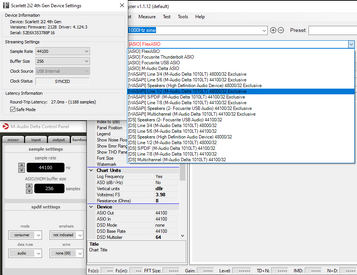I ran a test using the motherboard onboard sound out to the 1010LT input. The calibration and stepped THD ran successfully. The distortion levels are seriously bad, this is a very old PC, but it works using the FlexASIO WDM-KS driver. When I tested FlexASIO with the Scarlett only, full I/O, it worked. But switching back to the Scarlet-1010LT started having an error that I still cannot eliminate, "Unable to start ASIO capture". Rebooting does not help. Yet WDM-KS driver still does. It seems that once something causes a problem with Wasapi in Windows, it doesn't recover. So I'm testing using the FlexASIO WDM-KS driver now. It never fails.
It looks like the problem using Scarlett-to-1010LT is related to USB. REW must time out on input due to delay in the output from the Scarlett on USB.
It looks like the problem using Scarlett-to-1010LT is related to USB. REW must time out on input due to delay in the output from the Scarlett on USB.















